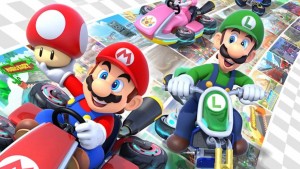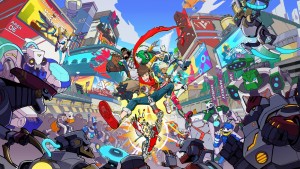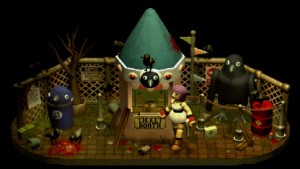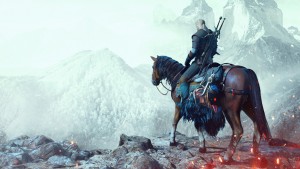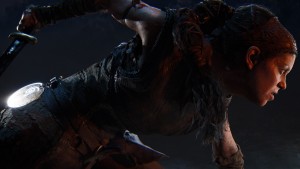Please support Game Informer. Print magazine subscriptions are less than $2 per issue
Afterwords: SSX

Snowboarding fans waited over five years for EA Sports to revive its over-the-top SSX franchise. While the reboot thrilled some by continuing the series' legacy of wild trick and breakneck races, others took issue with the frustrating Survive It mode. We talked to creative director Todd Batty to find out what changed, what got cut, and what he wishes he could bring back.
The game was originally announced with the subtitle "Deadly Descents." How soon after announcing did you decide to remove the subtitle? Did you change any of the content of the game as well or was it more of a marketing change?
That was really more on the marketing side of things. I've said this many times before, but we started off from day one with race it, trick it, and survive it as the three pillars of the game we were going to build. In the early days, probably because it was new, some people got excited about the survive it element. That's where the name and the funky logo for Deadly Descents was driven from. Then we announced and people freaked out and said, "Oh my god, where’s my SSX?!"
It was really tough.The game was still in concept, and we didn't have anything we could put out as far as true, actual gameplay. Our launch trailer at the VGAs was a complete CG outsourced video showing concept. Trying to put together a 40-second video that could show race it, trick it, and survive it in early concept phase was proving to be difficult, so the decision was made to lead with the new stuff, the survive it side, and see what the reaction was. Obviously the reaction was at best mixed. [laughs] I’ve seen some reports that it was 55% negative to 45% positive, but I can tell you that from the dev team side it felt like 90% negative.
Our goal very soon afterward was to make sure to let people know the game we were actually building and to start showing a lot of the things that were more familiar on the race it side and trick it side. That's why we dropped the Deadly Descents subtitle. It was a reboot, so we decided to keep it super clean and just call it SSX. I've heard a lot of conspiracy theories of people saying, "Oh, that first trailer came out, and then they probably completely changed directions." I’ve been in game development for many years. I would love to think that we could completely build race and trick and change everything about the game in the short period of time between when we announced the game and when we actually finished it. If we didn’t have all these things built long before we ever announced the game, we never would have got the game out and done the way that we did.
From the dev team side, we were obviously a little bit upset. Nobody likes to hear people getting upset and saying they aren't happy with the things we've done. But at the same time we were also optimistic and excited to get all the stuff out there that we had been building and new past fans of the franchise were going to love.
Why did you feel that survive it was a necessary addition to reviving the SSX franchise?
We certainly weren't the first attempt at EA to try to revive SSX. It's a game that a lot of people in the company have held very dear to their hearts and have been wanting to bring back for a long time. One of things I like to do is learn from past failures. We looked at a lot of the other earlier pitches at attempts to bring SSX back. What seemed like the constant barrier was it just feeling like an HD remake. EA was like, "We think SSX is awesome, but we also think that if we’re going to bring it back, we want to bring it back in a way that’s going to appeal to the largest, biggest group of gamers." It felt like it needed something new. It needed more innovation than just racing and tricking down the mountain.
We went back to the drawing board, threw our heads together, and said, "What if we add in a new type of win condition?" Snowboarding games have tried to do that a lot. They’ve added in a lot of mini-games, or you have to go down the mountain and grab collectibles, or you start 100 meters ahead of your opponent and you have to stay over 100 meters ahead of them. SSX On Tour had tons of that stuff, but they all felt like mini-games. It didn't feel like any of those were something that you could wrap an entire mode around.
So we looked at action-adventure games. The goal in action-adventure games is pretty simple. You have to make it from the beginning of the level to the end of the level without getting yourself killed. We wondered what that would look and feel like under an SSX wrapper, trying to keep things crazy and exaggerated and super-arcadey. That's where the ideas for wingsuits and environmental hazards came from.
Not every reviewer or player had as big of a problem with the survive it courses as I did, but it’s definitely the most controversial change to the series. Moving forward, do you see survive it as a permanent part of the franchise?
You're absolutely right. It has been mixed. One of the reasons we wanted to build so many tracks and build such a massive world was an attempt to try to appeal to the biggest group of gamers possible. Our game is so big and has such diverse, different types of gameplay experiences that I was certain not everybody would love everything. There's things that people like and things that people don't like.
But I'm also very confident that everybody is going to fine something that they like, and there will be tons of content of that variety to gorge yourself on. I’ve probably put in over 100 hours on SSX since we shipped, and I still only have medals on 22 of 153 drops, which means I’ve only actually played 22 drops in our game…but I’ve spent over 100 hours doing so. I have my own favorite types of drops. I don't like tricking on survival courses, but at the same time, if we can put a trick win condition on one of those, there may be some people that like that. Why wouldn't we?
Then we tried to make sure that we pointed people to the easiest and most globally, universally liked experiences as the ones they should go to first. If you look at Explore mode, most of the feature peak drops are free. You don't have to pay anything to unlock them. Some of the crazy, back country, super difficult courses are ones that our hardcore gamers love, but those cost 100,000 or 150,000 credits to unlock. We tried to tune the game in such a way that we would get people into the easier courses first.
The future that I see for SSX is one that is ideally determined 100% by our community. Our community has done an amazing job partnering with us from the time that we reached out and started to develop a relationship with them and asked them, "What do you want? What’s important to you?" I've got over 50 friends on PS3 and about 70 friends on 360 who are almost all members of our community. I'm watching what they like. We're chatting while we're playing the game. I think the future of SSX ideally is determined by them. They're the people that are going to be playing the game, supporting the game, and telling their friends to play the game. If they think we should scrap survive it but try something else that's new, then we would listen to that. If they want more survive it but want it to be tweaked or changed in some way, I think we would do that.
Your gamertag is known in the community, and they talk about your scores specifically. Developers don’t always get this invested in the community for their games.
This might sound cheesy, but this is unquestionably the first game in over ten years of making games that I've been this excited about playing after working on it for so long. I had a lot of fun with NBA Street when we first launched it, but what's awesome about asynchronous play and RiderNet is that I can play against 50 people at the same time. Every time I pick up the controller and throw down a ghost in Explore, if I put up a bad run, I know they'll be making fun of me for what a terrible run that is. I obsessively have to try to fix it before I log off so that people can play against a ghost that's good.
I saw one forum poster who saw your ghost and accused you of using developer tricks to get ahead, but someone responded and defended you by saying, "No, I think he's just that good."
We got that in the demo. The gameplay producer and I friended a bunch of people in the community even just on the demo, and we put down a pretty high trick score and pretty good race times. For a short period, everyone was like, "They’re using cheats! They’re not level 4 equipment like the rest of us!" Then slowly but surely the community started to beat us. By the time the game launched, we were well down the leaderboard on the demo.
It's been humbling to say the least seeing what some of the people in our community are capable of doing. That's what’s so awesome. Every day I have a new nemesis from the community. Somebody puts up a race time that I'll spend two or three hours trying to beat, just chasing their ghost. Eventually I have to admit that I just won't be able to do it. It's really fun for me to be able to interact with the community in that way. It's also valuable, because I see the way people are interacting with the game. I see what they're drawn to. I see what they like and what they don't like. That's going to help us shape some key decisions in the future.
This is an extended version of an interview that appeared in Game Informer issue #229.

I like the asynchronous multiplayer approach, but I have seen some players complaining about not being able to easily do more traditional multiplayer with friends and not being able to do split-screen. Would you consider ever going back to that style of multiplayer?
I definitely think we would explore going back to it. Removing split-screen was one of the toughest decisions of my entire career. I pushed and held on to split-screen for probably much longer than I should have, because I am an old-school gamer, and some of my fondest memories of the original SSX are playing it on the couch against other people in the room.
At the end of the day, it's a very expensive feature. We didn't just take it out lightly. We built this game off a brand new code base, and split-screen didn't exist in that. Adding it in was a tremendous amount of effort on our rendering team, who were already trying to keep up with some of our other goals, like how fast we wanted to move down the mountain and how big our mountains were and trying to make sure that's still streamed. We heavily prioritized keeping an awesome, solid framerate. Like a lot of things in development, it ended up on the chopping block simply because it was going to be a lot of work, and the people who would have to work on that were doing other stuff that was extremely important.
That was a tough one for me, and it's definitely something that I would love to see brought back. It's unfortunate that a lot of games have moved away from split-screen, and I'm sure it's very much for a lot of the same reasons that I just cited. You don't see it even in many straight, pure racing games now. You don't see a lot of games actually still supporting split-screen.
With traditional multiplayer, it again came down to with the time and resources at our disposal, if we wanted to do a traditional multiplayer online model, we probably could have done that, but it would have come at the expense of doing RiderNet and the asynchronous model and all of the online features that you see in our game. We looked at the game that we had built, and the one we decided to go with was the asynchronous model. Given that we are not just a racing game, I think it’s the best one for the game that we’ve built. I'm a big believer in picking the things you're going to do and then doing them really, really well, rather than trying to do everything and doing all of it half-assed. We think that the online model that we built is unquestionably the best one for the game.
In the past, a lot of SSX's head-to-head multiplayer element always revolved around racing. We looked at SSX and thought that first and foremost it's a trick game. My fondest memories of SSX were passing the controller and trying to set high scores. We tried to figure out how that translates into a modern online world. That's where Global Events came about. It's that turn-based, who's-going-to-set-the-highest-score multiplayer, but we can all do it at the same time with live updates as to how we're doing relative to each other. Racing would obviously traditionally be done as 3-2-1, out of the start gate, here we go. We thought if we go with more of a time trials approach for racing, we could use the same system, so we could further invest and make that system as rich and robust and awesome as it is. That's definitely not a decision that I regret. I still think it's the best model for the game that we've built. That said, I would love to have done both.
Another thing that's awesome that you might not notice because it's a lack of something, but there's no latency in our online. With no collisions online, it also means that players can't grief. I can’t imagine what online players would have been doing with that in the game – jumping out of the helicopter and just sitting there and punching people as they all fall. It would have been great for the guy punching people as they go past him but maybe not so great for the other people playing. Some of our levels are hard and challenging enough. If I'm going down one, and I have a 100-move combo built up worth 10 million points, do I really want somebody to come flying in from off-screen, knock me down, and ruin that combo? Combat and tricking really didn't feel like they lived very well hand-in-hand.
In the PS2-era SSX games, if you went off course, you would just reset onto the track. In this game, if you fall into a chasm you either rewind or completely restart the race. Is there any specific reasons you decided to avoid the fast reset back onto the track?
If you ask the hardcore SSX community, that fast reset onto the track actually turned into a pretty terrible exploit in the past games. It's a tough challenge to figure out where you're going to put somebody back on the track. Older SSX games still had chasms and death pits that you had to jump over. You would have to jump over a chasm, and if you didn't have enough speed or didn't jump it quite properly, you wouldn't clear the chasm. If you pressed select or fell into it, the game would reset you back up the track, and one of two things would happen.
Sometimes it would set you back up the track but not far enough back to get enough speed to actually make that jump. Then you'd get into this perpetual loop of being sent back and trying to make the jump and not making it, which eventually led to a reset. Resets were a lot longer and a lot slower in the past. The second thing that would happen is figuring out how to use it as a cheat. Sometimes you could go into those chasms, and instead of jumping, just fly off it. You wouldn't make it to the other side, but just as you're about to crash into the far wall, you could press the select button, and it would warp you forward onto the track. You could actually use that to cut time. The community called those wormholes, but it was just the game logic trying to figure out the best place to put you back on the track. Of course, players figured out ways to exploit that.
That's something we were trying to get away from. It's always a challenge to try to figure out how to deal with failure in a quick way. One of the things we realized through early focus testing was that some people who were high score setters were effectively resetting a lot, especially on some of the more difficult tracks. We challenged our rendering team and our systems team to make resets as fast as humanly possible. They’re about four or five seconds. That's a big testament to them. I wouldn't say it's a perfect system, but it's not exploitable, which was my goal. We knew there would be a lot of obsessive high-score setting in this game. We wanted to make sure as much as possible that everyone was on a level playing field.
I've seen some people annoyed at the decision to make characters unlocks. By the time that you've unlocked the character you want, you've likely already built up a certain amount of experience with someone else and are arguably better off staying with that character.
It's actually more of an illusion than a reality. We wanted to make the game as friendly as possible to players of different skill levels. If you are an absolutely new person who's not very good at the game, we wanted you to be able to get quick enough rewards and level up your character to motivate you to keep going. The first four levels or so of experience are super easy to get. Zoe is the first character who's unlocked, and if you have any real skill at all, by the time you finish the tutorial or have played one run, she's already at level four or level five. You might think, "Oh my god, she’s already at level five, I don’t want to have to unlock a new character and spend all that time," but you're not realizing that it didn’t really take you any time to get to that point. I can level a character up to level seven or eight in two or three runs.
It's a perception thing that I totally acknowledge is there. When you're trying to make a game accessible to new people, sometimes it gives the perception to veterans or more experienced players that things aren't what they seem. To unlock a character costs 10,000 credits, which is about the equivalent of a peso in our game. We thought about doing a global XP system where it's just you that levels up independent of characters, but I think it gives the game more legs and replayability to level the characters up individually. A lot of the people in the community level up specific characters for specific events. I've leveled up Elise for wingsuit racing. I've leveled up Mac for tricking. I've leveled up Moby for more pure, non-wingsuit racing. If you want to just dedicate yourself to one character, you can do that and get them to level 10. If you want to play with all the different characters, there's a lot to do and lots of extra replayability in that.
You had mentioned the possibility of doing some crazier SSX Tricky-style tracks as DLC. Is there still any chance of that happening?
I would love to talk to you about things like that, but I'm prohibited from even acknowledging whether or not there will ever be DLC in SSX. I have to keep my mouth shut on that one. We are listening to our community and fans, and hopefully at some point in the future we'll be able to give them some cool stuff.
What do you see as the future for the SSX series moving forward from here?
I've said this vocally for the last year or so, but one of the great things that Peter Moore and John Riccitiello and some of the other senior people at EA have said is that they really want to evolve our business into not just doing one-off titles but really building and investing in franchises. Our goal with SSX was to lay down the foundation and deliver something modernized, next-gen, but true to the SSX gameplay heritage that we thought has been really lacking in this console generation. I think we've done that. We're really proud of the game that we've built. It seems like people are really enjoying it and having lots of fun and getting super-addicted. I absolutely hope that this is the beginning of the franchise. If people adopt it and it does well, then I'd love to see more SSX driven by what the people want and what our community wants.

